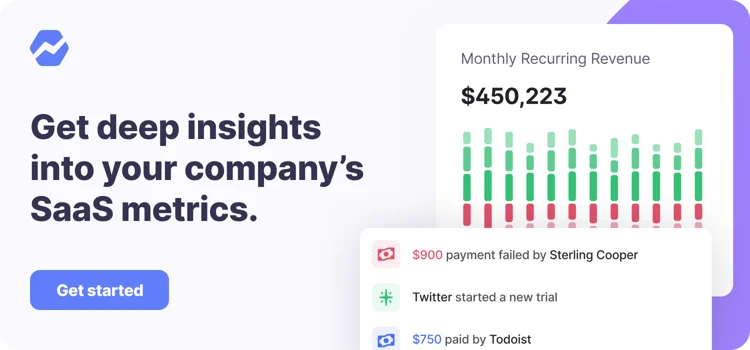Table of Contents

Whether you created your SaaS product to help solve a problem you had or because you wanted some extra income, the truth is that your SaaS business is a valuable asset.
Running a profitable SaaS business allows you to take control of your own schedule – some would even say your life!
But what’s the final checkpoint for your business?
At some point in your journey, you’ll need to think about your exit strategy from your SaaS startup. It’s natural to lose interest or just not have the resources to keep a startup going or scaling.
The issue comes when you haven’t prepared for an exit. In that case, you’ll need to either sell your business at a fraction of its previous value or close it down. We’d hate for that to happen to you.
Whether you’re an early-stage founder or you’ve built up an established B2B SaaS business, it’s crucial to understand how valuations work and how you can prepare for an exit when the time is right for you.
Why Would You Sell?
You might feel uncomfortable with the idea of selling your startup. After all, it’s probably funded your travels across the world or helped you build up other projects at the same time.
The most common reasons for selling a business usually relate to the time-cost tradeoff of running it.
Even if the business is in maintenance mode and you’re working less than an hour on it each week, you still need to commit mental bandwidth and resources to make sure it’s ticking along okay. By that point, you might not have the motivation or capital to scale it to the next level.
Selling when you’re ready to move on allows you to raise a huge amount of capital to reinvest in other interests. Luckily for you, there’s a massive market of buyers who’ll be happy to purchase your startup.
It’s a Seller’s Market
A wide variety of buyers are looking to acquire SaaS companies of all sizes.
The ideal buyer for lower-priced businesses might be a solopreneur looking for a hands-off stream of income. Bigger companies acquire SaaS products with a large customer base to improve the other assets in their portfolio.
An example of synergy could be an ecommerce brand aggregator acquiring an ecommerce tool to scale the primary business. A recent example of this is Instacart acquiring Caper AI for $350 million to streamline the online shopping experience.
The key to a successful sale is to make sure you have healthy unit economics.
Important SaaS Metrics and Unit Economics
Unit economics and SaaS metrics like churn rate will always be important. But when valuing a business, it’s important not to get too hung up on any single metric.
These figures should be looked at from a holistic perspective. Focusing on improving a single metric too much might not make a significant difference to your business’s valuation.
That being said, let’s explore what some of the key metrics are and how you can improve them.
Churn Rate

Churn rate basically defines the long-term trajectory of a business. Low churn allows recurring revenue to grow, improves growth rate, and reduces the risk of long-term value loss.
SMB SaaS companies tend to have higher churn rates due to their lower demand and less sophisticated needs. Customers using smaller SaaS tools tend to be brand-agnostic, switching tools to see which fit them. These types of customers are also usually price-inelastic and need tools within a specific budget.
High churn is understandable for newer startups, but it does indicate that a tool may be a poor market fit, have limited demand, or struggle to compete against similar products.
So what’s an optimal churn rate, outside of “as low as possible”?
It depends on who you ask, but it generally ranges from 3.2% to 11.2%.
What’s an acceptable churn rate for your business? It really depends on what niche you’re in and why your clients are churning.
If you don’t already know what your churn rate is, check out this churn analysis guide.
Customer Acquisition Cost (CAC) & Customer Lifetime Value (LTV)
CAC is the cost of acquiring a customer and it’s pretty simple to work out: just take what you spent on marketing and sales and divide it by the number of customers.
LTV measures the average value of a customer from the moment they sign up to the moment they churn. There are a few ways to work LTV out, but the simplest is something like this:
LTV = (Total average order) X (Average no. of purchases over 12 months) X (Retention time (in years))
Each metric on its own is useful, but the LTV/CAC ratio is what’s most important for valuations. Aim to reach a 3:1 ratio, which is considered ideal.
These three metrics are among the most talked about. Now, let’s look at how they come into play for SaaS valuations.
Valuing SaaS Companies Based on SDE, EBITDA, and MRR
There are three ways to look at SaaS valuations:
- seller discretionary earnings (SDE);
- earnings before interest, taxes, depreciation, and amortization (EBITDA);
- monthly recurring revenue (MRR).
No matter which formula you use, they boil down to how much money your SaaS business generates and set that number against a multiple that reflects the quality of your business.
For SDE and EBITDA, you would set annual profit against an annual multiple; typically, this multiple ranges from 2-10X.
MRR is set against a monthly multiple that usually ranges from 25X to 100X.
The amount of annual revenue your business generates will determine which formula to use.
SDE for Businesses Valued at Less Than $5 Million
SDE reflects how much money your business makes after all expenses are paid and any salaries are added back into the business.
The figure is one way to indicate a business’s earning potential and is often confused with EBITDA.
Businesses valued with SDE tend to earn less than $2 million in annual recurring revenue (ARR) and tend to be run by solopreneurs. Year-on-year revenue growth is usually less than 50%.
EBITDA for Businesses Valued Above $5 Million
Businesses that make over $5 million in ARR will likely use EBITDA, as the business will have a high growth velocity and a more fleshed-out infrastructure.
The owners tend to be thought leaders in their industry and operations are developed with department heads and teams working under them.
There are usually more stakeholders than the owner. EBITDA takes many factors into consideration, which is why this metric is more suitable for mature and complex businesses.
MRR for Fast-Growing SaaS Companies
MRR is a popular way to value SaaS businesses because it’s a key indicator of revenue growth.
Investors prefer looking at MRR rather than ARR because annual recurring revenue doesn’t provide proof of churn.
Big SaaS brands generating high MRR can raise a lot of money during seed funding rounds, despite not generating profit. For less mature brands that haven’t built up a name, people prefer monthly plans; with a recognizable brand, they can charge a discounted annual plan.
A newer startup could be valued using MRR if it’s experiencing rapid growth and meets the following criteria:
- ARR is more than $2 million;
- Around 50% growth year after year;
- Founder involvement isn’t important for the business’s survival.
Improve SaaS Business Conversion Rate Optimization
Get deep insights into MRR, churn, LTV and more to grow your business
The Three Key Elements of Attractive Assets
No matter which valuation formula is used, investors look for proof of these three characteristics in a business:
- Transferability
- Sustainability
- Scalability
1. Transferability
Investors look for businesses that can be easily transferred. To prepare your business for a sale, focus on making the transition as seamless as possible. Payment processing can cause huge headaches for buyers if the account can’t be transferred.
If you’re using PayPal, we recommend switching to another service like Payoneer. Subscriptions on PayPal are non-transferable, so you’d have to switch over to another service. If you wait until a deal has been confirmed before you switch, the deal could be delayed by months. PayPay is also notorious for freezing accounts when their anti-fraud algorithms are triggered.
Payment processing aside, you’ll need to document your business operations as much as possible to make your business plug and play. Creating well-documented code that can be understood by another developer ensures continuity if the new owner wants to develop the product or fix any issues.
Standard operating procedures (SOPs) help buyers to learn how to run the business as you did; SOPs are great for training new staff or to refer back to during the transitional period when the business changes hands.
While buyers are doing their due diligence, they’ll need to see clean financials. This will include tax returns from the past three years, a balance sheet, income statements, and cash flow.
Compiling your finances into a profit and loss (P&L) statement is the easiest way to communicate this information. Hiring a bookkeeper or accountant to stay on top of your financials will help you out here a lot.
Buyers will also want to know your unit economics and how it’s been calculated. Using a service like Baremetrics will help you to keep track of key metrics like churn and LTV so that you can measure performance and easily present the info when needed.
2. Sustainability
Scaling your revenue (MRR) is great, but it needs to be done efficiently.
A business with high MRR won’t be worth as much if the churn rate is through the roof and your retention rate is poor. Buyers pay attention to your LTV, churn rate, and conversion rate optimization.
For your churn rate, the lower, the better. How low it should be depends on the industry in which your SaaS business operates in. But a buyer will look at how effective your measures are to reduce churn and whether there’s room for improvement.
Have you optimized your pricing through plans that match your target audience’s needs?
One plan may be your hero “product” for attracting the most customers. Buyers will want to know what other pricing plans you’ve tried and whether they were successful.
Investors will also look at how efficient your operations are at acquiring new leads. Organic lead generation is highly attractive because there are no expenses involved; if you have other customer acquisition channels (CACs), the conversion rates will indicate whether these marketing channels are worth maintaining.
3. Scalability
The most exciting prospect of SaaS businesses is their room for growth.
Buyers will be looking at how scalable your business is based on a number of factors, such as the LTV/CAC ratio.
A low LTV/CAC ratio may indicate that more capital is needed than expected to scale a business; on the other hand, a high ratio could mean your growth is slower than your competitors because you aren’t spending enough on marketing.
Then you’ve got your customer type based on which businesses you support. Enterprise customers prefer annual plans for closer-contact support, while SMB and smaller customers prefer monthly plans to see how well the tool integrates with their business.
Other Factors That Affect the Sales Multiple
Software businesses are valued somewhat differently than other business models such as ecommerce because of their different growth levers.
Factors that we consider for other businesses don’t have as much weight for SaaS.
Important factors that will be taken into account include how involved the owner is in the business and the growth trends indicated by key SaaS metrics.
Investors pay attention to other considerations outside of unit economics that aren’t always quantifiable.
- Competition – is there enough differentiation from existing software companies?
- Product lifecycle – does your product need any major updates to stay relevant?
- Technical knowledge – does the new owner require deep technical programming knowledge to be able to run the business, or can that knowledge be easily transferred?
- CAC per channel – how effective is your marketing strategy at generating new customers in a cost-effective way?
- Diversification – how many single points of failure are there in your business?
- Saturation – is there room for growth in the current market?
Buyers have a lot to consider outside of just how much money a business makes before making a SaaS acquisition. Let’s look at how you can make the decision to buy your business easier for investors while increasing the sales value.
How to Make Your SaaS Business More Attractive and Valuable
No two buyers will have the same due diligence criteria; but there’s plenty of overlap in general criteria that you can apply to widen your buyer pool.
A lot of it comes down to increasing your business’s growth rate in a sustainable manner. All businesses have room for improvement. Increasing your business’s profitability without cutting corners will do you a world of favors.

Search engine optimization (SEO) is one of the most cost-efficient acquisition channels. Generating high volumes of organic traffic means that people can find your content and site without any ad spend.
Writing articles for blogs is the most common way to generate organic traffic; you stand a higher chance of your content being found for your chosen keywords if it’s optimized for SEO.
To increase trust signals for search engines, you’ll need to gain backlinks. You can do this through manual outreach, such as via guest posting, leaving comments on forums, or paying for them.
Paying for backlinks can be a risky strategy, since you could be penalized for having a spammy backlink profile.
1. Develop a Full Marketing Strategy
SEO is just one medium you can use to promote your product. Diversifying your marketing channels broadens your reach to different audiences.
Email marketing is a powerful way to build an addressable audience that doesn’t rely on search engine algorithms; in exchange for an email address, a subscriber will want to receive high-value content or offers.
The key to an email list is to build your funnel out by creating segmentations and automations. That way, you’re not having to manage individual emails and you can focus on developing quality content that will drive traffic and revenue.
Content marketing doesn’t just end at SEO and email lists. Social media can be a powerful traffic driver depending on which platform you build a presence on. Most B2B SaaS companies will have a LinkedIn account or Twitter handle. To build organic reach via social media, you’ll need to post regularly.
The alternative is to use paid advertising. Facebook can be more effective due to its ability to target specific audiences if you decide to go this route.
PPC advertising on other search engines could also generate decent results if you’ve identified your target audience as hanging out on certain channels.
Podcasts can be a great way to generate quality content and collaborate with established figures in the industry. You can leverage someone else’s brand equity to raise awareness of your own product.
2. Protect Your Intellectual Property
If you have specific technology that gives your product an advantage over your competition, trademarking it can increase your brand’s value.
As we mentioned earlier, it’s important that any of your brand’s intellectual property from patents or trademarks can be transferred legally to the new owner.
Make sure you speak to a legal advisor if you’re planning to register a trademark so that you can streamline the transfer process when you decide to sell. Even if you’ve never trademarked your brand before, it’s not too late to register today.
3. Improve Conversion Rate Optimization (CRO)
If you’ve got a steady flow of traffic through your various acquisition channels, optimizing them is a good source of growth.
Imagine CRO to be like a game. Your goal is to increase your click-through rates (CTR) for your content or promotions.
Use A/B split testing to send out variations of your landing page or other content. You can experiment with your CTAs, your copy, and image placements to see what generates the best results.
It’s worth setting up different tests at the start of each week or month to start gathering data. Over time, you’ll notice which types of CTAs and where they’re placed have the most impact.
4. Lower the Number of Annual Plans on Offer
Selling annual plans increases your upfront cash flow, but it’s also the least attractive option unless you’re an established brand that can afford to offer discounted annual plans.
While offering annual plans can help with retention, investors prefer seeing MRR over ARR. Recurring annual revenue can be wildly unpredictable, whereas MRR provides a more granular insight into the business’s recurring revenue stream.
If you’re growing your business and want to get the word out about your brand, offering discounted annual plans isn’t a bad idea. However, if you’re planning for an exit, start steering towards increasing your MRR.
Try to encourage more users to take out monthly plans by expanding your pricing plan offerings. A subscriber base spread out across a variety of monthly plans mitigates the risk of customers churning heavily on your most popular pricing plan, making your business more attractive to potential buyers.
Offer tailored plans based on individual needs if there are select cases/loyal customers who don’t fit into current pricing plans.
5. Lower Churn
Every SaaS business is on the hamster wheel of lowering churn rates – it can always be lower than it currently is.
Lower churn by providing excellent customer service for higher customer retention.
Setting up chatbots that provide automated responses can give customers quick and straightforward answers to common questions without needing to set up a call. If a chatbot can’t resolve an issue, offer live chat support. You can outsource customer support to virtual assistants, although it’s best to have someone with technical expertise on hand for any technical issues.
How do you make your tool easy to use? By creating an excellent onboarding experience. People look for quick solutions nowadays that are easy to learn, so new customers are more likely to stick with your tool if you show just how simple it is to use from day one.
To find out what else people like or dislike about your tool, take surveys from your customer base and ask for feedback.
From the responses, you can implement new features to improve your tool and UI.
Prepare for a Sale
Before you list your business for sale, there are a few things you need to prepare to set yourself up for success.
The first thing is to get your P&L statement ready. If you’ve never done that before, you’ll need:
- the past three years of taxes;
- your balance sheet;
- your assets;
- a cash flow statement.
Start lowering your involvement in the team by outsourcing or building an in-house team. The less an investor needs to manage while running the business, the more attractive your SaaS company will be.
Take time to think about how much you want to sell for and what type of deal structuring you’ll accept. If you’re unsure how much your business is worth, a free valuation tool can give you a ballpark estimate.
You’re more likely to receive a full cash upfront offer if your business is low 6 figures.
For 7-figure deals and above, there’ll probably be deal structuring involved. All institutional buyers work on different types of deal structures, although it changes on a case-by-case basis. Consider whether you’re planning to stay with your business after the sale or whether you want to be entirely removed from operations.
If you want to optimize your business by implementing some of the tips mentioned above, give it at least 6 months. You’ll have time to plan a strategy and make any changes according to the results.
Where to Sell
You’ve got two main options for selling – through a private sale or through a broker.
There are other routes, but these are the most common ways to sell a SaaS company.
Going it Alone Through a Private Sale
A private sale probably makes sense if you’ve built up a large customer base or audience. There’s a chance someone from your circles of associates might be a qualified buyer. However, keep in mind that there’s no protection for the buyer or seller in a private sale.
Unless you both set out clear guidelines and expectations on the deal process, it can get messy with communications and negotiations – especially if this is the first time either of you has done a deal.
If you haven’t built up a large audience, be prepared to entertain a lot of poor offers. In the car sales industry, people who waste your time with low-ball prices are called tire-kickers. They window shop and see what’s available. Then, they try their luck to see if any seller is desperate enough to take the bait.
You’d think people wouldn’t fall for this, but we’ve seen it happen more than you’d expect.
First-time sellers have no experience, and their FOMO kicks in.
They list their business for sale hoping for offers to flood in. But when crickets respond, the fear sets in.
“What if I can’t sell my business?”
“What if no one wants to buy it?”
Naturally, they take the first offer that comes along, even if the offer falls way below expectations. The alternative route is to use a reputable broker to help safely negotiate the deal.
Working With a Broker for a Win-Win Situation
People often think that selling privately will save them a lot of money in the form of commission fees.
While that might be true, using a broker increases the likelihood of selling your business. Brokers attract a much larger crowd of potential buyers. They’ll need to show proof they can afford to buy a SaaS business to use the service.
Using a broker means you’ll have your business put in front of a huge deal flow of hungry buyers looking for great deals on online businesses.
Business brokers also have processes in place to protect buyers and sellers. Communication is streamlined on a single platform, and it’s easier to talk to a qualified buyer.
If you’ve spoken to someone who you think is the right acquirer for your business, you can negotiate a sale price. The broker will help you set expectations between parties so that you will get a fair price and the buyer will be happy with their acquisition.
What’s important is that you have an exit strategy in place.
If you’re thinking about selling your business but not sure where to start, speak with an experienced business analyst. At the very least, you’ll know what you need to prepare if you decide to sell your business.
All the data your startup needs
Get deep insights into your company’s MRR, churn and other vital metrics for your SaaS business.


